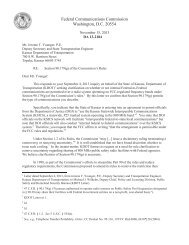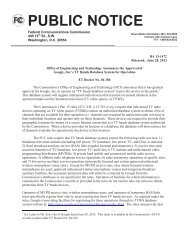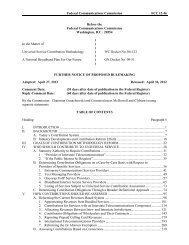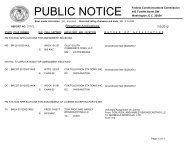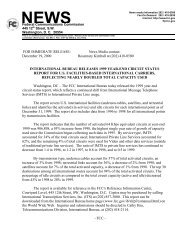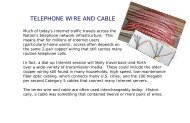You also want an ePaper? Increase the reach of your titles
YUMPU automatically turns print PDFs into web optimized ePapers that Google loves.
1885<br />
1891<br />
1892<br />
to<br />
1893<br />
1896<br />
to<br />
1897<br />
1899<br />
1901<br />
1902<br />
Page 2<br />
GENERAL<br />
RADIO<br />
TIMELINE<br />
Heinrich Hertz proved<br />
that electricity can be<br />
transmitted in electromagnetic<br />
waves. He<br />
conducted experiments<br />
in sending and<br />
receiving these waves<br />
during the late 1880s.<br />
<strong>Radio</strong>s (what we’d<br />
call wireless telegraphs<br />
today) began to<br />
appear on ships at sea.<br />
This reduced the isolation<br />
<strong>of</strong> the ships thus<br />
improving both reliability<br />
and safety.<br />
Nikola Tesla wirelessly<br />
transmitted<br />
electromagnetic energy.<br />
He made the<br />
first public demonstration<br />
<strong>of</strong> radio in St.<br />
Louis in 1893.<br />
Guglielmo Marconi<br />
filed for patent protection<br />
<strong>of</strong> his radio apparatus.<br />
He established<br />
the Wireless Telegraph<br />
and Signal<br />
Company in 1897.<br />
The R.F. Matthews<br />
was the first ship to<br />
request emergency<br />
assistance using a<br />
wireless apparatus<br />
(Marconi’s system).<br />
First transAtlantic<br />
signal sent-by Marconi<br />
from Ireland to<br />
Canada.<br />
Amateur (today<br />
known as “ham”)<br />
radio introduced to the<br />
U.S. via a Scientific<br />
American article on<br />
“How to Construct an<br />
Efficient Wireless<br />
Telegraphy Apparatus<br />
at Small Cost.”<br />
...Continued on last page...<br />
T<br />
here are hundreds, if not thousands, <strong>of</strong> uses <strong>of</strong> radio<br />
spectrum and technology. Everything from baby monitors<br />
and broadcasting to radar and radio beacons are<br />
applications <strong>of</strong> radio. These two pages focus on the<br />
first historical use <strong>of</strong> radio—mobile radio.<br />
Technologies<br />
that underpin<br />
mobile radio were<br />
first put to work in<br />
the 1890s on<br />
behalf <strong>of</strong> oceangoing<br />
ships, which<br />
had previously<br />
relied on carrier<br />
pigeons and flags<br />
for their<br />
communications.<br />
In 1910, Frederick<br />
Baldwin and John<br />
McCurdy were<br />
the first to trail<br />
an aerial behind<br />
their bi-plane to<br />
demonstrate<br />
radio’s uses for<br />
aviation.<br />
In 1921, Detroit<br />
police<br />
commissioner<br />
William<br />
Rutledge was<br />
the first public safety<br />
<strong>of</strong>ficial to use radio<br />
equipped vehicles.<br />
Today, maritime, aviation,<br />
and land-based mobile radio<br />
systems remain among the<br />
most important nonbroadcast<br />
uses <strong>of</strong> the<br />
radio spectrum.<br />
But mobile radio isn’t just<br />
for safety purposes today.<br />
Taxi drivers, tow truck<br />
dispatchers,<br />
and package delivery services<br />
are just a few <strong>of</strong> the<br />
businesses that make innovative<br />
use <strong>of</strong> mobile radio.<br />
In fact, mobile radio has<br />
become such a key tool in<br />
all business communications<br />
that one <strong>of</strong> the <strong>FCC</strong>’s<br />
major challenges is ensur-<br />
Inside Focus on Mobile <strong>Radio</strong><br />
MOBILE RADIO AT WORK<br />
Robert Loraine was the<br />
second pilot to demonstrate<br />
wireless transmission<br />
from a<br />
plane (1910).<br />
Detroit police radio car<br />
with antennas running<br />
across the ro<strong>of</strong> (1921).<br />
The Titanic, showing its<br />
radio antennas strung from<br />
bow to stern (1912).<br />
ing efficient and effective<br />
use <strong>of</strong> the radio spectrum by<br />
business, while guaranteeing<br />
the reliability and interoperability<br />
<strong>of</strong> all public<br />
safety radio uses.<br />
In finding a way to make this<br />
all work, the <strong>FCC</strong> helps<br />
make America a safer and<br />
better place to live.



